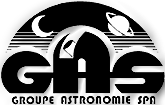
13 January 2007
McNaught Farewell
The comet was an easy binocular (10x42) object in the afternoon of 13.01.07. Around 15:10 UTC i.e. more than half an hour before sunset (15:44), it became visible to the naked eye. At sunset, it was hardly less visible than Venus. In view of the small elongation and altitude of the comet, it must have been substantially brighter than Venus, about -5 mag (indeed, recent magnitude estimates range between -4.7 and -6). A very compact object, with a tail visible over less than 1°, hence less spectacular than on 10.01.07.
Numerous short exposure images were taken with the D100 and the Maksutov, in the 1000/11 and 550/6.3 configurations. Here birds in the foreground, before sunset (15:10 & 15:41); a "mock comet" made of cirrus and contrails (15:53); and an airplane, then cloud bands next to the setting comet (16:05 & 16:11).
jld
Numerous short exposure images were taken with the D100 and the Maksutov, in the 1000/11 and 550/6.3 configurations. Here birds in the foreground, before sunset (15:10 & 15:41); a "mock comet" made of cirrus and contrails (15:53); and an airplane, then cloud bands next to the setting comet (16:05 & 16:11).
jld
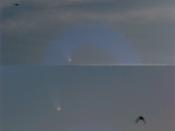
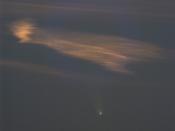
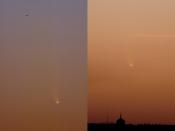
20:19:14 -
ejehin -
Catégorie : AstroPhotos
-----------------------------------------------------------------
-----------------------------------------------------------------
![]()
Total des votes : 8 - Evaluation : 2.88
Mc Naught de jour!
WARNING - Comet now less than 6° from the Sun. Do not attempt to look with the naked eye or binoculars unless the Sun is hidden e.g. by a building. Observation with SCT telescopes is risky since sunrays may hit the primary mirror and concentrate besides the secondary mirror, therefore over-heating its mount. Do not point at the comet for long periods; use a long baffle in front of the telescope.
Some clearings came over Munich, allowing visual observations of McNaught: C11, x110, orange filter / no filter: pseudo-nucleus surface brightness at least as large as Venus; hints of an antisolar shell, better visible during "eclipses" = Sun behind clouds but comet in blue sky.
Many images taken with D100 and C11, Contrast Booster & no filter, f/11 & f/22. Here a composite of 3 images, no filter, f/11, 1/2000s, ISO 200, 10:45 UTC, cropped to FOV = 13'.
Some videos taken before clouds arrived. Now, clearings are coming again, thus I'll go to EPO room 7917 within 1 hour.
jld
Some clearings came over Munich, allowing visual observations of McNaught: C11, x110, orange filter / no filter: pseudo-nucleus surface brightness at least as large as Venus; hints of an antisolar shell, better visible during "eclipses" = Sun behind clouds but comet in blue sky.
Many images taken with D100 and C11, Contrast Booster & no filter, f/11 & f/22. Here a composite of 3 images, no filter, f/11, 1/2000s, ISO 200, 10:45 UTC, cropped to FOV = 13'.
Some videos taken before clouds arrived. Now, clearings are coming again, thus I'll go to EPO room 7917 within 1 hour.
jld
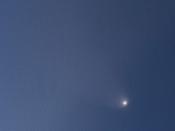
16:34:46 -
ejehin -
Catégorie : AstroPhotos
-----------------------------------------------------------------
-----------------------------------------------------------------
![]()
Total des votes : 8 - Evaluation : 3.63
